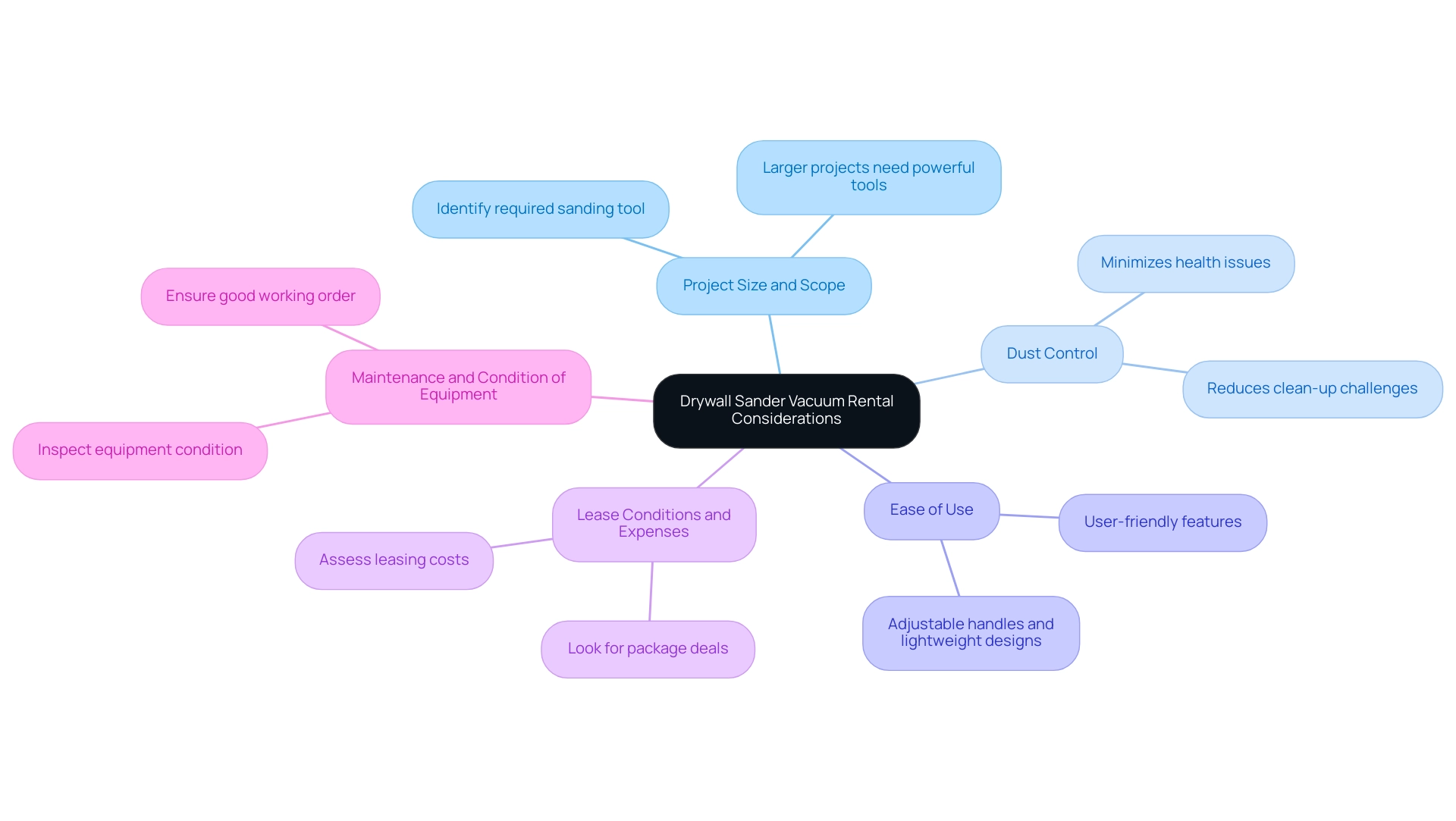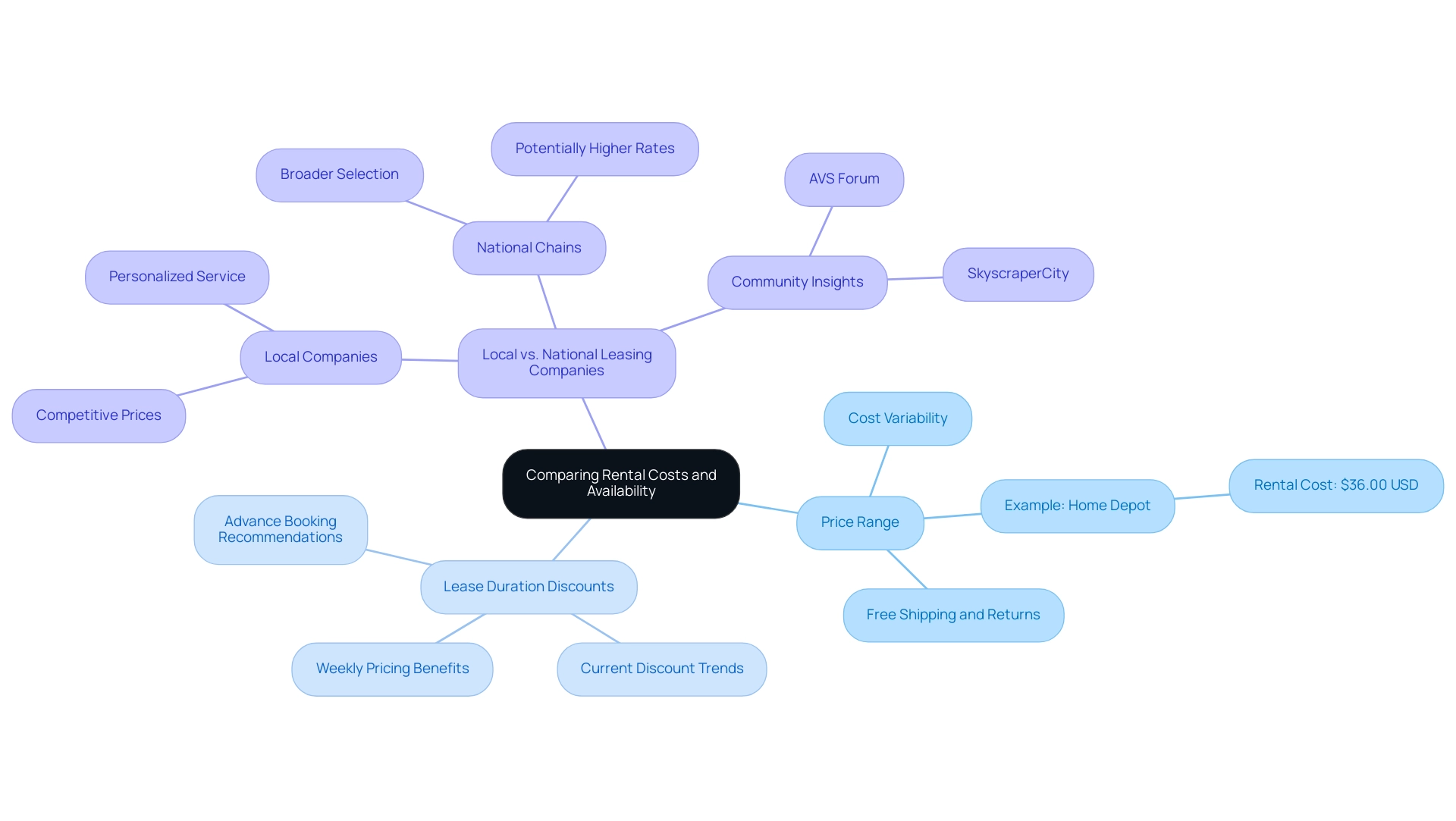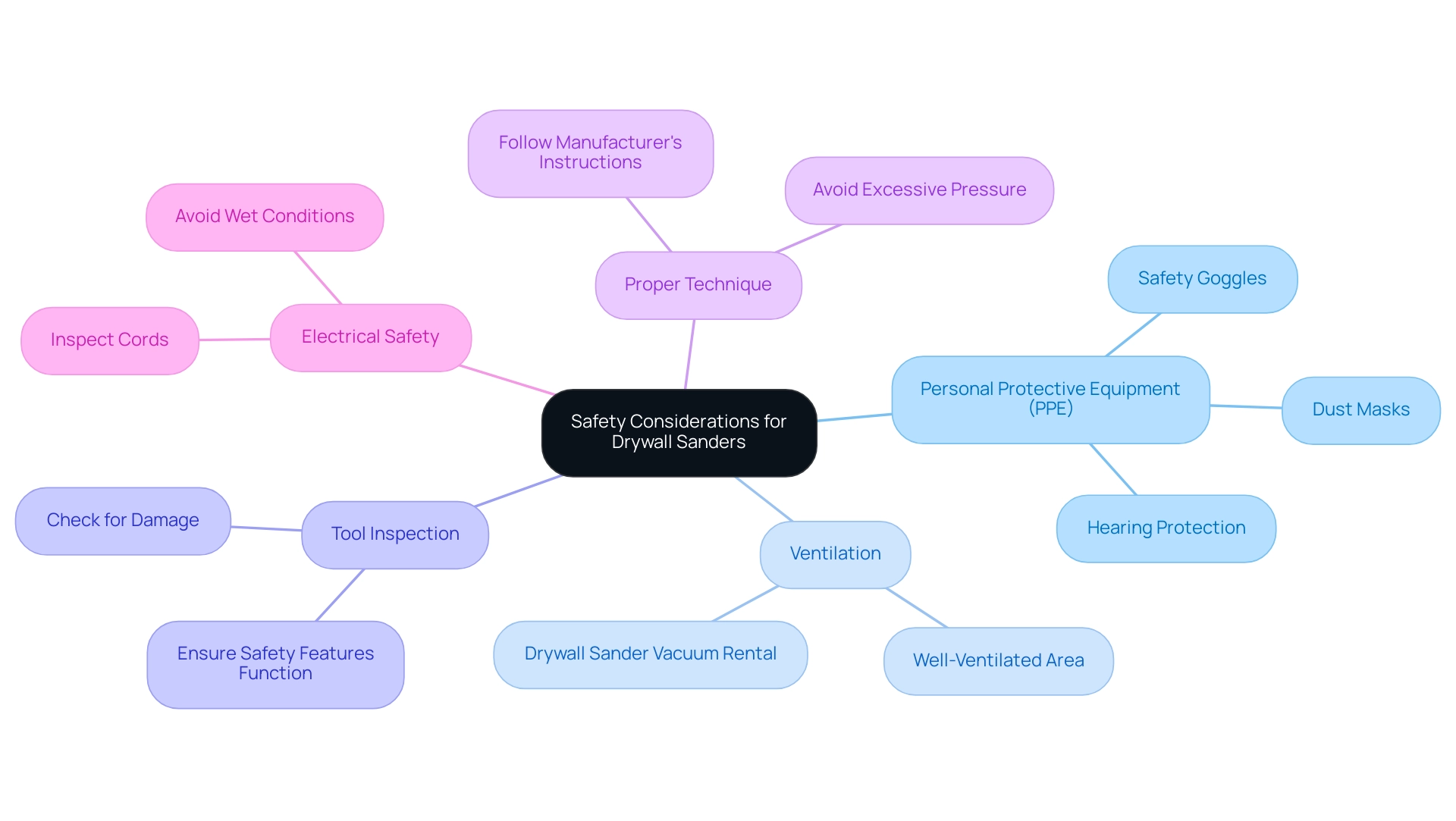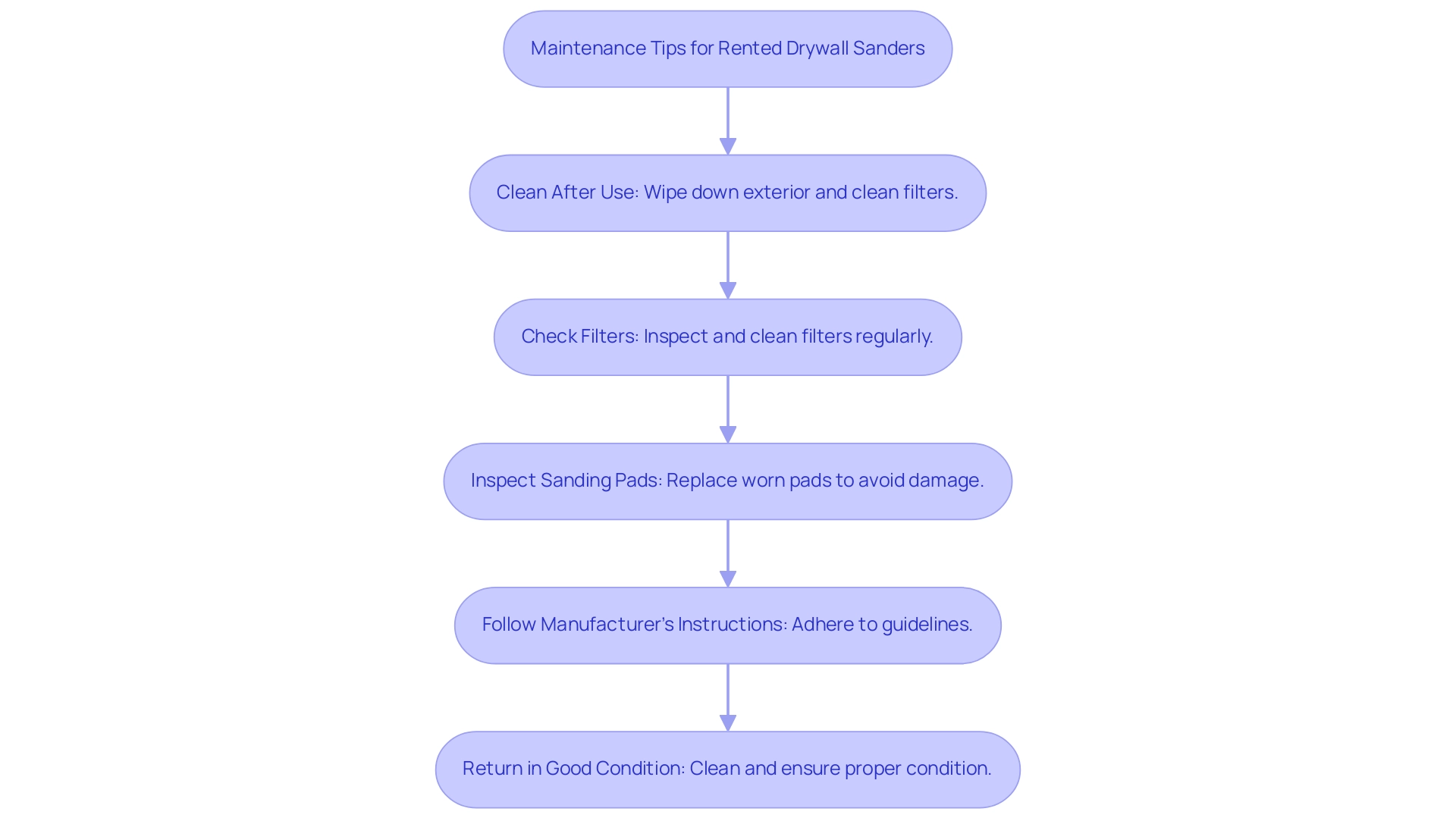Introduction
Choosing the right drywall sander for a project can be a challenging endeavor, especially with the myriad of options available for rent. Each type of sander serves a unique purpose, and understanding their distinct features is crucial for achieving the desired finish while maximizing efficiency. From the versatility of orbital sanders to the aggressive power of rotary sanders, the selection process requires careful consideration of project size, dust control needs, and safety protocols.
As construction project managers navigate the landscape of rental costs and equipment availability, they must also prioritize maintenance and the proper use of tools to ensure a successful outcome. This guide delves into the essential aspects of drywall sander rentals, providing insights that empower users to make informed decisions and elevate their project results.
Exploring Different Types of Drywall Sanders for Rent
When contemplating rental options for wall finishing tools, including drywall sander vacuum rental, it’s crucial to comprehend the different varieties available, as each is designed for particular jobs. The most common types include:
- Orbital Tools: Known for their versatility, orbital tools excel in delivering a smooth finish, making them suitable for both DIY enthusiasts and professionals.
Their design allows for easy control, which enhances user experience in finishing work. - Rotary Tools: These devices are engineered for aggressive sanding, making them ideal for heavy-duty tasks such as stripping old paint or thick layers of drywall compound. However, they demand a higher skill level to operate effectively, making them best suited for experienced users.
- Pole Sanders: Ideal for large spaces, pole tools are crafted with adjustable handles that enable access to elevated ceilings and walls, improving maneuverability and effectiveness.
- Vacuum Tools: Integrating a drywall sander vacuum rental system, these devices are crucial for minimizing dust during operations. This feature is particularly significant in professional settings, where keeping a tidy workspace and ensuring respiratory health is crucial.
Safety Requirements: When utilizing sanding equipment, it is essential to follow safety protocols, which include wearing eye protection, safety footwear, and gloves to protect against potential risks.
Recent advancements in wall finishing technology have further enhanced these tools’ efficiency, demonstrated by Festool's newest lineup designed to optimize jobsite and workshop workflows. The wall finishing tool fitted with a dust collector, a 120V operation, and a 62” handle exemplifies the advancements aimed at achieving professional results—boasting a 9” round capacity and generating 1,400-2,000 orbits per minute. Furthermore, the Porter Cable wall finishing tool weighs 9 lbs, rendering it a manageable choice for different users.
By comprehending the distinct features of each type and the related safety requirements, construction managers can make informed decisions when selecting the most suitable drywall sander vacuum rental for their specific needs.

Key Considerations for Choosing the Right Drywall Sander Vacuum Rental
When choosing a drywall vacuum rental, several key considerations can guide your decision:
- Project Size and Scope: Evaluate the scale of your undertaking to identify the kind of sanding tool required. Larger projects may require more powerful tools with vacuum capabilities to handle extensive sanding tasks efficiently.
- Dust Control: Consider the importance of dust control in your workspace. Using a drywall sander vacuum rental is highly recommended for minimizing dust, which can lead to health issues and clean-up challenges.
- Ease of Use: Look for sanders that are user-friendly, especially if you're not experienced with sanding tools. Features like adjustable handles and lightweight designs can enhance usability.
- Lease Conditions and Expenses: Assess leasing costs and terms meticulously. Some leasing companies may provide package deals for extended periods, which can save you money.
- Maintenance and Condition of Equipment: Inspect the equipment condition before renting. Ensure that the sanding tool has been well-maintained and is in good working order to avoid interruptions during your project.
By considering these factors, you can make a more informed choice that aligns with your project needs and enhances your overall efficiency.

Comparing Rental Costs and Availability
When assessing wall finishing tool leases, several important factors concerning expenses and accessibility deserve consideration:
- Price Range: The costs for drywall machines can vary greatly, usually spanning from $30 to $100 per day, based on the machine's specifications and the provider. For instance, renting a sander from Home Depot is priced at $36.00 USD. To ensure you secure the best value, it's crucial to compare rates from various drywall sander vacuum rental services. Additionally, many providers offer free shipping and returns, which can further enhance cost-effectiveness.
- Lease Duration Discounts: Numerous leasing firms offer significant reductions for prolonged lease periods. If your task necessitates the drywall sander vacuum rental for several days, inquiring about weekly pricing can lead to significant savings compared to daily fees. Staying informed about current discount trends for equipment leasing can also help project managers maximize their budgets. It's essential to confirm the availability of the drywall sander vacuum rental model you intend to rent, particularly during peak construction seasons when demand surges. To avoid last-minute issues, consider booking well in advance.
- Local vs. National Leasing Companies: While local leasing businesses often offer competitive prices and personalized service, national chains may boast a broader selection. However, their rates may not always be the most economical. Conducting thorough research on both options can help you identify the most advantageous solution for drywall sander vacuum rental. Engaging with communities such as AVS Forum and SkyscraperCity can provide valuable insights and recommendations from other construction project managers.
By carefully assessing these factors and utilizing available resources, construction project managers can effectively manage their budgets while ensuring access to the tools necessary for successful project completion.

Safety Considerations When Using Drywall Sanders
Utilizing drywall tools can present specific risks if appropriate safety precautions are not adhered to. Here are key safety considerations:
- Personal Protective Equipment (PPE): Always wear appropriate PPE, including dust masks or respirators, safety goggles, and hearing protection.
This equipment is essential for protecting against dust inhalation and noise exposure. - Ventilation: Ensure that the area is well-ventilated to minimize dust accumulation and maintain air quality. If possible, use a drywall sander vacuum rental to reduce airborne particles.
- Tool Inspection: Before use, inspect the device for any signs of damage or wear. Ensure that all safety features are functional and that the tool is in good working condition.
- Proper Technique: Use the sanding tool according to the manufacturer's instructions.
Avoid applying excessive pressure, which can lead to uneven sanding and increased risk of injury. - Electrical Safety: If operating electric tools, ensure that the cords are in good condition and avoid using them in wet conditions to prevent electrical hazards.
By adhering to these safety considerations, users can ensure a safer working environment and minimize the risk of accidents while using finishing tools.

Maintenance Tips for Rented Drywall Sanders
To maximize the performance and longevity of rented drywall sanders, project managers should adhere to the following maintenance tips:
- Clean After Use: It is essential to clean the tool thoroughly after each application to prevent the accumulation of harmful dust from wall materials. Utilize a damp cloth to wipe down the exterior and ensure that all filters are free of debris. This step is vital, as .
- Check Filters: For the drywall sander vacuum rental, it is essential to regularly inspect and clean the filters throughout the borrowing duration. Clogged filters not only diminish suction power but also increase dust exposure, compromising air quality on the job site. Consider using a drywall sander vacuum rental along with a shop vacuum hose extension, available in 10 and 15-foot increments, to enhance cleaning efficiency and reach difficult areas.
- Inspect Sanding Pads: Regularly examine the sanding pads for signs of wear. If they appear worn, replacing them is necessary to avoid poor sanding results and potential damage to the surface being worked on. This proactive measure can save time and resources in the long run.
- Follow Manufacturer's Instructions: Always comply with the manufacturer's maintenance and operation guidelines. Adhering to these instructions ensures the tool operates correctly and safely, preventing accidents and malfunctions on the job site.
- Return in Good Condition: When returning the rented sander, ensure it is cleaned and in the same condition as when it was received. This practice not only avoids additional fees but also fosters a positive leasing experience. As suggested by industry experts, to ensure proper soaking and cleaning, "put them in a bucket of water and forget about them."
By implementing these maintenance strategies, project managers can significantly enhance their rental experience. A recent case study highlighted that tools rinsed in clean water and thoroughly dried with a rag or towel effectively prevented moisture-related damage. This underscores the importance of proper cleaning techniques, as ensuring all areas are dried thoroughly can extend the life of the equipment and maintain its performance.

Conclusion
Understanding the various types of drywall sanders and their specific applications is crucial for any project manager looking to achieve high-quality results. From the versatility of orbital sanders to the aggressive capabilities of rotary sanders, each tool serves a distinct purpose that can significantly influence the outcome of a project. Additionally, considering factors such as project size, dust control, and ease of use can streamline the selection process, ensuring that the right equipment is chosen for the task at hand.
Cost and availability are also critical aspects when renting drywall sanders. By comparing rental rates, understanding the benefits of longer rental periods, and knowing the local market, project managers can make informed decisions that align with their budgets. Furthermore, prioritizing safety by adhering to established protocols and maintaining the rented equipment enhances the overall efficiency and safety of the work environment.
In summary, navigating the landscape of drywall sander rentals requires careful consideration of various factors, including the type of sander, project requirements, and safety measures. By taking the time to understand these elements, project managers can ensure they select the right tools for their projects, leading to superior results and a safer workspace. The right preparation and knowledge empower users to tackle their drywall sanding tasks with confidence and professionalism, ultimately elevating the quality of their work.
Frequently Asked Questions
What are the common types of wall finishing tools available for rental?
The most common types include Orbital Tools, which provide a smooth finish for various users; Rotary Tools, designed for aggressive sanding and heavy-duty tasks; Pole Sanders, which are ideal for large spaces and elevated surfaces; and Vacuum Tools, which minimize dust during operations.
What are the safety requirements when using sanding equipment?
Essential safety protocols include wearing eye protection, safety footwear, and gloves to protect against potential risks.
What factors should be considered when choosing a drywall vacuum rental?
Key considerations include project size and scope, dust control, ease of use, lease conditions and expenses, and the maintenance and condition of the equipment.
How much does it typically cost to rent drywall sanders?
Rental costs for drywall machines generally range from $30 to $100 per day, depending on the machine's specifications and the provider.
Are there discounts available for longer rental periods?
Yes, many leasing firms offer significant discounts for prolonged lease periods, and it’s advisable to inquire about weekly pricing for extended rentals.
What should I check before renting a drywall sander vacuum?
Before renting, inspect the equipment for maintenance, ensuring it is in good working order to avoid interruptions during your project.
What personal protective equipment (PPE) is recommended when using drywall tools?
Recommended PPE includes dust masks or respirators, safety goggles, and hearing protection to guard against dust inhalation and noise exposure.
How can I maintain rented drywall sanders for optimal performance?
To maintain rented sanders, clean them after use, check filters regularly, inspect sanding pads for wear, follow the manufacturer’s instructions, and return the equipment in good condition.




